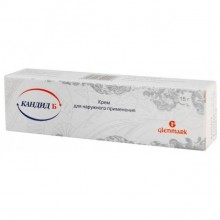



Candide-B - local antifungal, local anti-inflammatory, antiexudative, antipruritic, anti-allergic.
Pharmacodynamics
Clotrimazole is an imidazole derivative, a broad-spectrum antifungal agent. The effect of the drug is associated with impaired synthesis of ergosterol, which is part of the cell membrane of fungi, which causes a change in its structure and properties and leads to cell lysis. Dermatophytes, yeast fungi (genusCandida, Torulopsis glabrata, Rhodotorula), mold fungi, as well as pathogenPityriasis versicolor (lichen colored) and the causative agent of erythrasma.
In addition, it has an antimicrobial effect against gram-positive (staphylococci and streptococci) and gram-negative bacteria(Bacteroides, Gardnerella vaginalis)as well as in relation toTrichomonas vaginalis.
Beclomethasone dipropionate has anti-inflammatory, anti-allergic, anti-exudative and antipruritic action. When externally administered beclomethasone dipropionate suppresses inflammatory and allergic skin reactions as well as reactions associated with enhanced proliferation, which leads to a decrease in objective symptoms (erythema, edema, lichenification) and subjective sensations (itching, irritation, pain).
Fungal infections of the skin, especially accompanied by acute eczematous manifestations:
1 g of cream contains:
Active substances: Clotrimazole 10 mg, beclomethasone 250 μg;
Excipients: white petrolatum jelly, liquid paraffin, cytomeacrogol wax, benzyl alcohol, methylparaben, propylparaben, bottled hydroxytoluene, propylene glycol, monosodium phosphate, anhydrous sodium phosphate, purified water.
No customer reviews for the moment.
Topically, on pre-washed and dried affected skin, gently rubbing, applied with a thin layer 2-3 times a day.
When inguinal athlete’s disease, microsporia of smooth skin and candidiasis, the course of treatment is 2 weeks; with athlete's foot - 4 weeks. If necessary, long-term use should be applied less frequently - every other day. In the treatment of chronic diseases, treatment should continue for some time after the disappearance of all symptoms, in order to avoid recurrence of the disease.
Side effects are usually mild. Local allergic reactions are possible - redness of the skin, burning sensation and tingling at the site of application of the drug.
Rarely, as with the use of other corticosteroids, acne-like changes, hypopigmentation, striae, skin atrophy, hypertrichosis, telangiectasia, and secondary skin infections may develop.
External use of Candida B cream in pregnant women is allowed in cases where the intended benefit to the mother exceeds the risk to the fetus. In such cases, the use of the drug should be short and limited to small areas of the skin.
It is not known whether the drug penetrates into the mother's milk, so during the breastfeeding period the use of the drug Candid B is possible only under strict indications, and the drug should not be applied to the skin of the mammary gland before feeding.
If the first use of Candid B Cream develops a hypersensitivity reaction on the skin (itching, burning or redness), you should immediately discontinue the use of the drug and consult a doctor.
If possible, long-term therapy should be avoided, especially in children, because of the possible suppression of adrenal function.
Application to an extensive surface or the use of occlusive dressings may result in systemic absorption of beclomethasone.
Avoid contact with the eye; Do not apply on the skin in the eye area or on the mucous membranes.
The development or spread of infection requires discontinuation of the drug and the appointment of antimicrobial therapy.
Bacterial infection is maintained in warm, humid conditions, including occlusive dressings, so the skin must be cleansed before applying the cream.
Data on the adverse effects of Candid B cream on the ability to drive vehicles and mechanisms is not available.
Symptoms: with prolonged use of beclomethasone on large surfaces of skin with impaired integrity or with the use of an occlusive dressing, as well as with prolonged use in children, side effects associated with the suppression and insufficiency of the adrenal cortex may occur.
Treatment: drug withdrawal and, if necessary, symptomatic therapy.
Studies and clinical trials of Candid B (Click to expand)